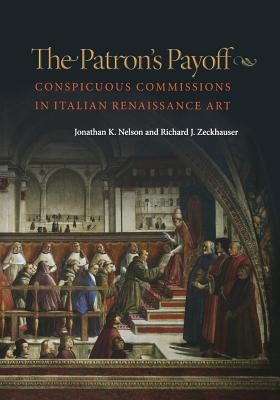
- We will send in 10–14 business days.
- Author: Jonathan K Nelson
- Publisher: Princeton University Press
- ISBN-10: 0691161941
- ISBN-13: 9780691161945
- Format: 17.8 x 25.4 x 1.4 cm, minkšti viršeliai
- Language: English
- SAVE -10% with code: EXTRA
Reviews
Description
In The Patron's Payoff, Jonathan Nelson and Richard Zeckhauser apply the innovative methods of information economics to the study of art. Their findings, written in highly accessible prose, are surprising and important. Building on three economic concepts--signaling, signposting, and stretching--the book develops the first systematic methodology for assessing the meaning of art patronage and provides a broad and useful framework for understanding how works of art functioned in Renaissance Italy.
The authors discuss how patrons used conspicuous commissions to establish and signal their wealth and status, and the book explores the impact that individual works had on society. The ways in which artists met their patrons' needs for self-promotion dramatically affected the nature and appearance of paintings, sculptures, and buildings. The Patron's Payoff presents a new conceptual structure that allows readers to explore the relationships among the main players in the commissioning game--patrons, artists, and audiences--and to understand how commissioned art transmits information. This book facilitates comparisons of art from different periods and shows the interplay of artists and patrons working to produce mutual benefits subject to an array of limiting factors. The authors engage several art historians to look at what economic models reveal about the material culture of Italy, ca. 1300�1600, and beyond. Their case studies address such topics as private chapels and their decorations, donor portraits, and private palaces. In addition to the authors, the contributors are Molly Bourne, Kelley Helmstutler Di Dio, Thomas J. Loughman, and Larry Silver.EXTRA 10 % discount with code: EXTRA
The promotion ends in 22d.04:00:48
The discount code is valid when purchasing from 10 €. Discounts do not stack.
- Author: Jonathan K Nelson
- Publisher: Princeton University Press
- ISBN-10: 0691161941
- ISBN-13: 9780691161945
- Format: 17.8 x 25.4 x 1.4 cm, minkšti viršeliai
- Language: English English
In The Patron's Payoff, Jonathan Nelson and Richard Zeckhauser apply the innovative methods of information economics to the study of art. Their findings, written in highly accessible prose, are surprising and important. Building on three economic concepts--signaling, signposting, and stretching--the book develops the first systematic methodology for assessing the meaning of art patronage and provides a broad and useful framework for understanding how works of art functioned in Renaissance Italy.
The authors discuss how patrons used conspicuous commissions to establish and signal their wealth and status, and the book explores the impact that individual works had on society. The ways in which artists met their patrons' needs for self-promotion dramatically affected the nature and appearance of paintings, sculptures, and buildings. The Patron's Payoff presents a new conceptual structure that allows readers to explore the relationships among the main players in the commissioning game--patrons, artists, and audiences--and to understand how commissioned art transmits information. This book facilitates comparisons of art from different periods and shows the interplay of artists and patrons working to produce mutual benefits subject to an array of limiting factors. The authors engage several art historians to look at what economic models reveal about the material culture of Italy, ca. 1300�1600, and beyond. Their case studies address such topics as private chapels and their decorations, donor portraits, and private palaces. In addition to the authors, the contributors are Molly Bourne, Kelley Helmstutler Di Dio, Thomas J. Loughman, and Larry Silver.

Reviews